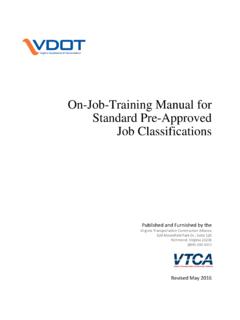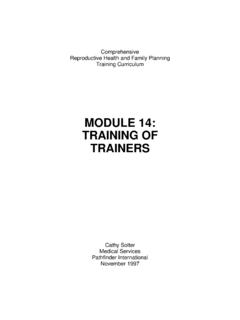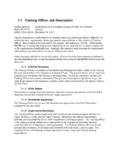Transcription of The effects of training on job satisfaction and service ...
1 Journal of Management and Marketing Research Volume 21. The effects of training on job satisfaction and service quality among temporary employees: the mediating role of affective commitment Ping He Troy University Hank Findley Troy University Robert Wheatley Troy University ABSTRACT: Temporary employees are important to organizations, but they do not feel the same way as do traditional workers. To maximize efficiency at work, organizations need to help temporary employees develop a sense of belongingness and improve productivity by investing in training . This study explores the causal relationship among temporary employees' training , job satisfaction , affective commitment, and employee perceived service quality based on Kirkpatrick's four-level training model. Through training reaction and training learning, trainees would modify their behaviors and change their results accordingly. Job satisfaction was used to indicate training behavior, and affective commitment and employee perceived service quality were used to measure training results.
2 The hypotheses were tested on a sample of 114 college students interning at an American hospitality company for a six-month period. Exploratory factor analysis was performed to identify five factors, and confirmatory factor analysis was conducted to analyze whether the factorial structure could be retrieved in the college intern sample. The findings from structural equation modeling supported that training was positively related to affective commitment and employee perceived service quality respectively. In addition, job satisfaction was positively associated with affective commitment. The research results highlighted that employers should implement training and use it as a strategic practice to improve the outcomes for both temporary employees and organizations. Keywords: training , Affective Commitment, Job satisfaction , Employee Perceived service Quality Copyright statement: Authors retain the copyright to the manuscripts published in AABRI.
3 Journals. Please see the AABRI Copyright Policy at The effects of training , Page 1. Journal of Management and Marketing Research Volume 21. INTRODUCTION. In today's highly competitive environment and tight labor market, temporary employees are considered as salient assets in achieving organizational effectiveness. According to Department of Labor, million temps were employed in 2014, compared to only 20,000 in 1956 (Greenhouse, 2014; Olson, 2011; Villarreal & Swanson, 2011). Although they are expected to leave after a certain period of time, temporary workers make substantial contributions to their organizations by offering flexibility to match fluctuations in production and service requirements (Connley, Gallagher, & Gilley, 2007) and saving their employers huge labor costs since normally they are provided with little or no fringe benefits. Managing temporary employees has become a significant challenge.
4 Temporary workers do not necessarily go above and beyond due to the psychological contract, as they are discouraged by the lack of insurance, benefits and job security (Feldman, Doerpinghaus, &. Turnley, 1994). And they often find themselves being treated in an impersonal way and assigned least challenging tasks and worst work schedules (Feldman et. al, 1994; Geber, 1993). Compared to traditional regular employees, temporary workers are found to be less satisfied with their jobs (Aletraris, 2010; De Graaf-Zijl, 2012) and less committed to their organizations (Felfe et al., 2008). However, as the nature of temporary workers and temporary workforce has changed overtime, now companies have realized the importance of valuable temporary workers who can undertake any professional and technical positions (Chambel & Sobral, 2011; Peck & Theodore, 1998; Melchionno, 1999) and thus make a huge impact on maintaining a competitive advantage.
5 However, temporary employees often complain about lack of training . Compared to training hours per permanent employee reported in the 2014 training Industry Report, temporary workers, in some cases, may only receive 10 minutes of training , which often leads to high rates of workplace injuries or even deaths (Greenhouse, 2014; training , 2014). Proper training not only provides employees with a safe work environment, but also positively affects organizational performance and effectiveness (Burke et al., 2011; Van Iddekinge et al., 2009). If temp workers experience positive outcomes, they may start to enjoy work more and foster organizational commitment (Finegold et al., 2005). This could potentially lead to a path for a permanent job when both parties have the intentions. As a matter of fact, 49 percent of temp workers surveyed by a staffing association claimed that temping help them land a full-time job (Greenhouse, 2014).
6 Therefore, organizations need to reevaluate their training strategies towards temp employees, which can turn their part-timers into productive full-timers once adequate training is provided (Chambel & Sobral, 2011; Finegold, Levenson, & Van Buren, 2005). This study seeks to contribute to the body of research of training and its effects on temporary employees' performance and job satisfaction mediated by affective commitment. Opinions from the paid interns who worked at an American hospitality organization for a period of six months are assessed. Paid interns are normally considered as temporary employees, if the internship is less than a year (Paul, Plevin, Sullivan & Connaughton LLP, 2011). LITERATURE REVIEW. training training is defined as a planned learning experience designed to bring about permanent change in an individual's knowledge, attitudes, or skills (Campbell, Dunnette, Lawler, & Weick, The effects of training , Page 2.)
7 Journal of Management and Marketing Research Volume 21. 1970). Studies show that organizations committed to training have facilitated their employees to improve their skills, enhance job satisfaction , and develop organizational commitment ( , Burke, 1995; Chambel & Sobral, 2011; Costen & Salazar, 2011; Mathieu, Tannenbaum, & Salas, 1992; Roehl & Swerdlow, 1999). The benefits and value of training are undeniably pivotal to an organization's success through maintaining high standards and consistency as well as keeping abreast of the fast-changing external environment. Efforts are required for organizations to make training accessible to employees, such as hiring training professionals, providing training materials, allowing employees to participate in training and making changes in scheduling, and so forth. training positively affects trainees' attitudes and behaviors at workplace if they apply newly learned knowledge and skills on the job.
8 When employees feel they are valued by their organizations, they are motivated to do their best at work (American Psychological Association, 2012) and obliged to reciprocate through means, such as modifying their behaviors and performing the tasks the way they are trained (Bulut & Culha, 2010; Eisenberger, Huntington, Hutchison, & Sowa, 1986). Kirkpatrick (1959, 1967) developed the four-level model to evaluate training : (1). Reaction: measuring what the trainees feel about various aspects of a training program, such as speaker, schedule, topic, etc.; (2) Learning: measuring knowledge acquired, skills improved, or attitudes changed due to training ; (3) Behavior: measuring on-the-job behavior changed due to training ; and (4) Results: measuring the final results due to training , including increased sales, higher productivity, bigger profits, reduced costs, less employee turnover and improved quality.
9 Due to its complexity, evaluation of training has been normally limited to the first two levels (Blanchard, Thacker, 2000; Bramley & Kitson, 1994). The other extreme is that many practitioners skip level 1, 2 and 3 and only measure the ultimate fourth level (Kirkpatrick, 1996). Even though training has been accredited for contribution in productivity and organizational performance (Scott & Meyer, 1991), very little research has evaluated the effect of training on temporary employees' outcomes. This research intends to investigate all the four levels in the Kirkpatrick's training model. The conceptual model identifies the relationships among four constructs: training , job satisfaction , affective commitment, and employee perceived service quality. training here covers reaction (level 1) and learning (level 2), with reaction'. indicating trainees' perception of trainer and training program, and learning' indicating knowledge and skills obtained through training .
10 In terms of behavior (level 3), defined as a person's intention to act toward someone or something in a certain way (Gibson et al., 2006), job satisfaction is used. In measuring the results of training (level 4), two constructs are introduced, , affective commitment and employee perceived service quality. Job satisfaction Job satisfaction is defined as the pleasurable emotional state resulting from the appraisal of one's job as achieving or facilitating the achievement of one's job values (Locke, 1969, p. 316). Howard and Frick (1996) suggested that job satisfaction is a multifaceted construct that includes both intrinsic and extrinsic job factors: the intrinsic factors are associated with ability utilization, achievement, authority, responsibility, etc., and extrinsic factors are related to compensation, advancement, workplace relationships, etc. When employees are unhappy about their jobs, it can lead to absenteeism and turnover, creating both economic and moral issues to their organizations (Porter & Steers, 1973; Tett & Meyer, 1993; Vroom, 1964).














